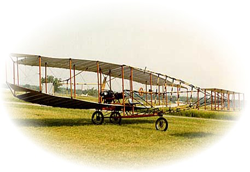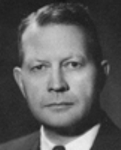
Several events and activities occurred in Manitoba to mark the 75th Anniversary of Air Cadets in Canada. All squadrons were encouraged to carryout activities in their towns and communities; such as, Static displays, Freedom of the City parades or Remembrance Day or Decoration Day Ceremonies, etc. more...
![]()
"On June 7, 2011 Bonnie Korzeniowski, the then MLA for St-James and Special Envoy for Military Affairs, had a private member's resolution passed to the Manitoba Legislature, more...
![]()
With the start of the Air Cadet Program in 1941 squadrons were started at schools throughout the province in both the cities and small communities alike. No statistics exist to indicate the number of air cadets that participated in the training but suffice it to be told that most recruits into the RCAF had had some level of the program before they enlisted. The program was popular with teen boys and the number of squadrons grew until 1945 when 59 Air Cadet Squadrons operated in the province. Some twenty squadrons functioned within the present boundaries of Winnipeg alone. more...
![]()
At wars end, many of the air cadet squadrons disbanded. Some amalgamated with other squadrons, some held on for a few years before they closed; some were to reopen after a period of time. Each of the twenty-four active Manitoba Air Cadet squadrons has its own history to tell and the following are some of those stories. more...
![]()

In 1940, WWI Fighter Ace, Wing Commander Donald R. MacLaren, D.S.O., M.C., D.F.C. was appointed as Manitoba's representative to the committee investigating the practicality of forming an Air Cadet program in Canada. The following year, on the formation of the Air Cadet League of Canada, he became the first Manitoba Provincial Committee Chairman, as well as the National President. He was succeeded in Manitoba by Mr. Gilbert M. Eaton in 1942. more...
![]()
Through the years that the Air Cadet Program has functioned in Manitoba many individuals have provided numerous hours of their time to ensure the program has been available for our Air Cadets. Some have passed on, in respect and in recognition of their many years and financial backing we have enclosed these short biographies. more...
![]()
 The Victoria Cross is awarded for most conspicuous bravery or some daring or pre-eminent act of
valour or self-sacrifice or extreme devotion to duty in the presence of the enemy. Three aviators
from Manitoba have been awarded this prestigious decoration for their acts of bravery. Two were
recipients during World War One the third during World War Two.
The Victoria Cross is awarded for most conspicuous bravery or some daring or pre-eminent act of
valour or self-sacrifice or extreme devotion to duty in the presence of the enemy. Three aviators
from Manitoba have been awarded this prestigious decoration for their acts of bravery. Two were
recipients during World War One the third during World War Two.
 Lieutenant-Colonel William George Barker, V.C., D.S.O. and bar, M.C.
and two bars, Croix de Guerre (France), Silver Medal of Military Valour (Italy) (November 2, 1894 - March 12, 1930)
of Dauphin, MB was a Canadian WWI fighter ace. He was awarded the Military Cross on 10th January, 1917;
first Bar on 18th July, 1917; the Distinguished Service Order on 18th February, 1918; second Bar to
Military Cross on 16th September, 1918; Bar to Distinguished Service Order on 2nd November, 1918 and
the Victoria Cross on 30th November, 1918.
Lieutenant-Colonel William George Barker, V.C., D.S.O. and bar, M.C.
and two bars, Croix de Guerre (France), Silver Medal of Military Valour (Italy) (November 2, 1894 - March 12, 1930)
of Dauphin, MB was a Canadian WWI fighter ace. He was awarded the Military Cross on 10th January, 1917;
first Bar on 18th July, 1917; the Distinguished Service Order on 18th February, 1918; second Bar to
Military Cross on 16th September, 1918; Bar to Distinguished Service Order on 2nd November, 1918 and
the Victoria Cross on 30th November, 1918.
He was inducted into Canada's Aviation Hall of Fame in 1973. His biography is available at Canadian Air Aces and Heroes web site. He is credited with 50 aircraft and nine balloon victories. No. 50 Royal Canadian Air Cadet Squadron of Dauphin, MB is named in his honour.
Recognition of William Barker from a recent article in the Toronto Globe and Mail.
noted on this page
- V.C. - Victoria Cross
- D.S.O. - Distinguished Service Order
- M.C. - Military Cross
- D.F.C. - Distinguished Flying Cross
- Croix de Guerre - France
- Silver Medal of Military Valour - Italy
- The inclusion of a bar means an additional award of the honour.
 Lieutenant Alan Arnett McLeod, V.C. (April 20, 1899 -
November 6, 1918) of Stonewall, MB was a Canadian WWI Reconnaissance pilot. In the spring of 1918,
within seconds after shooting down an enemy aircraft, seven members of Barron von Richtofen's
squadron attacked McLeod and his observer.
Lieutenant Alan Arnett McLeod, V.C. (April 20, 1899 -
November 6, 1918) of Stonewall, MB was a Canadian WWI Reconnaissance pilot. In the spring of 1918,
within seconds after shooting down an enemy aircraft, seven members of Barron von Richtofen's
squadron attacked McLeod and his observer.
Their Armstrong Whitworth was struck by enemy fire wounding McLeod and his observer and causing the aircraft to burst into flames. Because of the fire and the fact that the cockpit floor had fallen away, McLeod had to fly the plane from a standing position on the lower wing. The enemy continued to hail bullets against the bomber until it crash-landed. Both men were thrown clear of the aircraft on impact, which undoubtedly saved them from the explosion of the heavy bombs they did not have the opportunity to release. He was awarded the Victoria Cross for this action on September 4, 1918; he was nineteen years old.
He was credited with five aircraft and one balloon victories. He was inducted into Canada's Aviation Hall of Fame in 1973. His biography is available at Canadian Air Aces and Heroes web site. No. 301 Royal Canadian Air Cadet Squadron of Stonewall, MB is named in his honour.
 Pilot Officer Andrew Charles Mynarski, V.C. (October 14, 1916 -
June 13, 1944) of Winnipeg, MB was a Canadian WWII Air Gunner. Pilot Officer Mynarski was the
mid-upper gunner of a Lancaster aircraft, detailed to attack a target at Cambrai in France, on the
night of 12th June 1944. The aircraft was attacked from below and astern by an enemy fighter and
ultimately came down in flames.
Pilot Officer Andrew Charles Mynarski, V.C. (October 14, 1916 -
June 13, 1944) of Winnipeg, MB was a Canadian WWII Air Gunner. Pilot Officer Mynarski was the
mid-upper gunner of a Lancaster aircraft, detailed to attack a target at Cambrai in France, on the
night of 12th June 1944. The aircraft was attacked from below and astern by an enemy fighter and
ultimately came down in flames.
As an immediate result of the attack, both port engines failed. Fire broke out between the mid-upper turret and the rear turret, as well as in the port wing. The flames soon became fierce and the captain ordered the crew to abandon the aircraft.
Pilot Officer Mynarski left his turret and went towards the escape hatch. He then saw that the rear gunner was still in his turret and apparently unable to leave it. The turret was, in fact, immovable, since the hydraulic gear had been put out of action when the port engines failed, and the manual gear had been broken by the gunner in his attempts to escape. Without hesitation, Pilot Officer Mynarski made his way through the flames in an endeavour to reach the rear turret and release the gunner. Whilst so doing, his parachute and his clothing, up to the waist, were set on fire. All his efforts to move the turret and free the gunner were in vain. Eventually the rear gunner clearly indicated to him that there was nothing more he could do and that he should try to save his own life. Pilot Officer Mynarski reluctantly went back through the flames to the escape hatch. There, as a last gesture to the trapped gunner, he turned towards him, stood to attention in his flaming clothing and saluted, before he jumped out of the aircraft. Pilot Officer Mynarski's descent was seen by French people on the ground. Both his parachute and his clothing were on fire. He was found eventually by the French, but was so severely burned that he died from his injuries.
It was not until 1945 when the rear gunner, who survived the aircraft crash, was reunited with the rest of the crew that the details of his final moments on the aircraft were revealed. He related the story of the valiant efforts made by Mynarski to save him. Andrew Mynarski was subsequently awarded the Victoria Cross on 11 October 1946.
He was inducted into Canada's Aviation Hall of Fame in 1973. His biography is available at Canadian Air Aces and Heroes web site. No. 573 Royal Canadian Air Cadet Squadron of Winnipeg, MB is named in his honour.
![]()
On May 24, 1998, the officers and cadets of No. 176 Squadron were on exercise near Tulabi Falls, Manitoba, for the purpose of aircrew survival training. At approximately 1210 hours, as the squadron was packing to leave, two senior cadets went to the observation platform overlooking Tulabi Falls. While there they noticed a girl standing in the water at the mouth of the falls.
Tess Furtado, age 12, was washing her feet in the lake when she slipped and fell into the water. The intense current carried her over the falls. Flight Sergeants Nathan Fredrickson and Aaron Arnason ran from the observation deck down a trail beside the water and came to the last section of the falls. Fredrickson jumped into the water and swam out to Furtado. He grabbed onto her and kept her head above the turbulent water. Arnason called to a nearby fishing boat for assistance and arranged for more help from bystanders. The boat brought Tess and Fredrickson to shore.
While shaken up and injured, Furtado received no injuries to her head, neck or back and she had no broken bones or internal injuries.
"When I jumped onto the rocks I thought she was going to die," Fredrickson recalled. "Tess was in hysterics and bleeding. I had to get her to focus, so I gave her my watch and then she climbed toward me and I was able to get her to safety," said Fredrickson, who received cuts on his feet and slight hypothermia. "Most people in the same situation would do the same thing I did," he said. He noted that the happiest part of receiving the Air Cadet Medal of Bravery was that Furtado was the one who presented Fredrickson his medal and Arnason's Certificate of Commendation For Bravery.
![]()
Each summer senior Air Cadets from Manitoba are selected to visit countries that are part of the International Air Cadet Exchange Program. Several of the cadets have provided a review of their visits and their stories are below:
2009 IACE VISIT TO HONG KONG by Warrant Officer 2 Jessica Biggs
2010 IACE VISIT TO ISRAEL by Warrant Officer 2 Kamal Dhillon
2010 IACE VISIT TO NEW ZEALAND by Warrant Officer 2 Hannah Tufts
![]()
If you have an article that may be of interest to cadets, pass it on to us for inclusion on this page.







